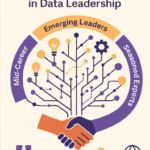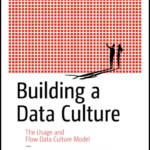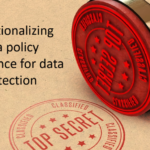
What Is a Data Strategy?
6 min read
Abstract: What is strategy, and more importantly, what is data strategy? This article describes three important and related concepts in organizational planning:
- What is strategy?
- What is a data strategy?
- How do they work together?
Introduction
It is important that organizations obtain specific, quantifiable value at various points on the path to realizing their data strategies. These take the form of value statements, which must be explicitly enumerated and shared across the organization. Otherwise, the entire effort could easily lose resources and attention to other, more visible initiatives. Before organizations can begin developing data strategies, it is necessary to understand data strategy’s role relative to the organization’s business strategy.
Strategy is the art and science of informed action to achieve a specific vision, an overarching objective or a higher purpose for a business enterprise (Daniell, 2007). At its core, strategy is about creating a default pattern in organizational decision- making at all levels. Whether the strategy is to win at sports or choose an option that results in the lowest organizational cost, the goal of any strategy is to make it easy for everyone involved to make the right decision. To that end, strategy is a literal pattern in a stream of decisions. For the strategy to be effective, however, it must complement and enhance the organizational strategy. To develop an effective strategy, organizations must perform an analysis of existing capabilities, choose from competing alternatives and develop an effective way to implement it.
A strategy represents the fundamental why of an organization’s existence—its mission! If an organization’s mission is not well- defined, it will be difficult to determine the proper role for the organization’s data strategy.
Strategy embraces many different disciplines and areas of business activity including competition, human resources, technology, structural organization, leadership, process and communication. It is a continuous effort which organizations need to perform as part of their daily activities to ensure that organizations continually evolve in response to a constantly changing business environment.
To understand what a strategy is, it is first important to understand why organizations need strategy. Let’s take a closer look.
Strategy Is About Why
…it’s not what you do, it’s why you do it…
Among many great TED Talks, Simon Sinek’s “How Great Leaders Inspire Action” is a favorite. Recorded in 2009, Sinek’s talk has enjoyed more than 25 million views. His point is simply: most of us are very good at describing what we do, and some of us are good at describing how we do things. Not many of us are good at describing why we do things. And we can get better at it.
Organizations are like people in this respect—most organizational communication focuses on the how. However, focusing on why provides motivational insight and several distinct advantages. For instance, notice the not-so-obvious advantage that comes from working in a top-down manner. According to Sinek, by concentrating communications, messaging and resources on motivation (the why), organizations can improve quality of communication and benefit from clarity of intent as others design the processes (the how) to implement the organizational mission. Similarly, when organizations focus strategically, they can generate well-designed business processes to effectively and efficiently produce the organization’s desired outcomes (the what).
In the military, the goal of strategy was summed up by General George S. Patton and has been referenced many times.
No bastard ever won a war by dying for his country. You won it by making the other poor dumb bastard die for his country (Wallace, 2000).
In the military, strategy is about defeating the enemy. In the private sector, businesses do not kill their enemies—instead, they defeat them in economic terms. Where the military fights on the battlefield, business organizations compete in markets. While there is no literal fighting, maintaining focus on the primary objective is still paramount. In business, there are two recognized approaches to winning the competitive marketplace: (1) being more effective and efficient than the competition and (2) capitalizing on “out innovating” than competition. (Some recognize successful hybrids (Magretta, 2011.). The public sector applies these criteria in a similar manner.
Defining Strategy: Consistent Guidance in a Stream of Decisions
To the surprise of many, strategy is a relatively new business term. Prior to the 1950s, people assumed that, if you were talking about strategy, you were using it in a military context. It was not until after the Second World War that strategy emerged in the business world.
Interestingly, use of the term strategy peaked around 2004 (according to Google Trends) and has steadily fallen in recent times. It is not entirely evident why the term’s use declined, but it is likely a result of inaccurate usage, overuse and lack of general understanding. If the current trend continues, the term might fade away like other ill-defined terms and phrases such as secret sauce, walk it back, break the Internet and uberize. (As an aside, Lake Superior State University (2016) banned the use of all these terms.) Even if incorrectly or overly used, the term strategy is still useful to our discussion. Liddell and Scott (1999) offer an immediately useful thought.
Strategy is a high-level plan to achieve one or more goals under conditions of uncertainty.
Strategy represents the best and most compelling case for providing guidance to the organization as to how it should achieve its objectives. Henry Mintzberg (1978) offers another definition, one which provides a bit more context for the term strategy: a pattern in a stream of decisions.
Mintzberg’s definition is particularly useful as it suggests that a plan is action-oriented and actionable versus being something people simply commit to memory to recite without having fundamental understanding of what the strategy is and what it requires. The following statement combines these two perspectives.
This definition allows individuals and groups at all organizational levels to easily learn and understand what decision patterns are and to use them to guide specific individual, lower-level decisions.
A specific strategy is then an expression of organizational objectives that identifies specific goals within a confined scope of operations to attain a specified advantage. Specific strategy articulation should also describe why the organization believes it can successfully implement this strategy and how that strategy will benefit the organization. Many have said:
Strategy is the highest-level guidance available to an organization, focusing activities on articulated goal achievement and providing direction and specific guidance when faced with a stream of decisions or uncertainties.
In any sector, for a strategy to be effective, it tends to satisfy four specific criteria (Roberts, 2004). A strategy:
- Expresses specific goals;
- Delineates a specific scope;
- Describes the advantage sought after; and
- Articulates why the strategy is achievable.
Strategy is the organization, and the organization is the strategy.
This indicates the depth of integration desirable—and most often required—to achieve results.
Because the environment is not static, organizations cannot expect to be successful doing things the way they have always done them. To achieve new business outcomes, organizations must make incremental adjustments over time and evolve in response to a fluid, changing business environment. Consequently, organizations must learn how to do things differently. They must discover new and innovative ways to manage change both inside and outside the organizations, and they must operate in a way that keeps pace with a rapidly changing business climate. If they do not do this, they will fail to maintain their current (relative) position.
What Is Data Strategy?
So far, we have discussed what strategy is and why it is important. We have also described strategy as an impetus for establishing organizational momentum and how strategy must embody the organization and vice versa. Let us now put these concepts together and describe the role played by a data strategy.
A data strategy is about supplying motivation centered around use of organizational data assets in support of organizational strategy. Specifically:
[d]ata strategy is the highest level [of] guidance available to an organization, focusing data-related activities on articulated data goal achievements and providing directional and specific guidance when faced with a stream of decisions or uncertainties about organizational data assets and their application toward business objectives.
Developing and maintaining an organizational data strategy should be a primary function for an enterprise data executive. Recall the criteria for a strategy: a strategy includes scope and achievable goals while targeting improvement of the organization’s data. Most organizations do not treat data as the organizational asset it is. However, data is every organization’s single, non-depletable, non-degrading, durable strategic asset.
References
1. Daniell, M. (2007). The Elements of Strategy (pp. 1–110).
2. Liddell, H, G. & Scott, R. (1999). A Greek-English Lexicon, on Perseus.
3. Magretta, J., Porter, M. E. & Magretta, J. P. (1970,January 01). Understanding Michael Porter: The Essential Guide to Competition and Strategy.
4. Mintzberg, H. (1978). Patterns in strategy formation. Management Science, 24(9), 1–15.
5. Robert, J. (2004). The Modern Firm. Oxford University Press.













